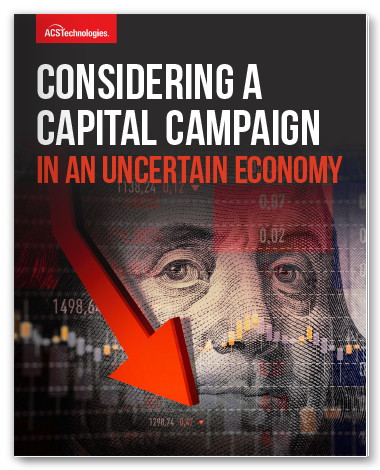Part 4 of 4
Many churches and organizations have delayed their capital campaign plans due to the uncertainty created by the pandemic and now the challenges of the economy. Record high prices, a tight labor market, and a rollercoaster stock market add to heartburn when making financial decisions. Considering a Capital Campaign in an Uncertain Economy…read on.
If your church has been exploring a capital campaign coming out of the pandemic and now find yourselves guessing about how today’s economy could impact you, this blog series has been providing guidance and advice about how to plan and move forward.
The fifth step in your campaign is the practical discernment of your opportunity and risks.
Any campaign is in some ways a leap of faith – you’re counting on donors who’ve indicated their passion and interest to come forward and stand by those commitments. The question becomes how much risk is too much risk?
If you’ve had honest and candid conversations with your donors to this point, and you believe you have a well-phased and thought-out plan, begin your planning phase in earnest. Again, we’ve covered the components of campaign planning in prior blogs. But beginning that silent phase, for example, will give you the formal opportunity to make early asks and commitments of your lead donors.
That silent phase will give you a thermometer for the receptiveness of your congregation to the timing of your campaign. If your lead donors are expressing concern due to their own economic circumstances and need to lower or stretch their pledge commitments out much further than anticipated, you will know it may be necessary to stay in the silent phase longer than you’d planned.
There are lots of formulas and recommendations for how much of the funding for your campaign needs to be pledged before you go “public” and move into soliciting donors who aren’t major givers. It’s important to run various versions of a campaign pyramid (that’s a fancy development term for a chart of how many givers you need at different levels to reach your goal). The internet is filled with lots of images and examples of campaign pyramids…but you’ll want to draft some versions for your project so you can judge internally how much support you need and have at any point.
Example of a campaign pyramid
For example, you may determine you need either 5 donors at $10,000 or 10 at $5,000 for an overall project of $75,000, where the balance will come from many lower-level donors over three years. If, after your silent phase asks of your lead prospects, you have three commitments of $5,000 and lots of maybes, it’s time to regroup. You had determined your broad base of members could commit $25,000 over three years in the original plan, so you don’t want to shift to hoping for $55,000+ instead from that group with no clear path for getting there. That is the recipe for a difficult or failed campaign. It’s important to stick to the donor pyramid needs you developed and hit pause if your upper-level commitments are not coming in as you had hoped.
Campaigns are a blast but they are also a lot of work and worry. Be patient and know God will lead you and your congregation as you carefully work toward the call of your particular ministry project. We hope this has been helpful in helping you frame the questions to ask yourself, your board and your members as you explore launching a campaign in an uncertain economy.
Launching a Capital Campaign in a Turbulent Economy
It can feel like record-high inflation, and stock market volatility are good reasons to keep kicking the can of a campaign launch down the road. And it’s true: Many churches and organizations have delayed their capital campaign plans due to the pandemic and now with the challenges of the economy.
But don’t give up yet. These concrete steps will help you assess how to best prepare for and launch a capital campaign for a much-needed project despite the current economic uncertainties.
For more information on consulting for Considering a Capital Campaign in an Uncertain Economy, visit ACST’s Consulting pages.
Tim has over 30 years of experience in Church, Non-Profit Administration, Management, and Fund Development. Serving as an Executive Pastor and Chief Development Officer in growing Churches and Non-Profit Organizations. He has provided a wide range of expertise and resources. Tim serves as the Founder and CEO of Non-Profit DNA. A boutique firm committed to helping nonprofits and churches. By building their capacity through fundraising, leadership, team building, staff recruiting, and coaching.





